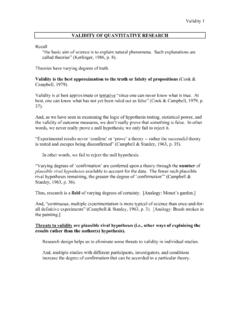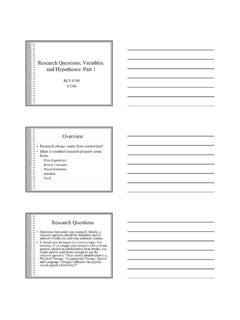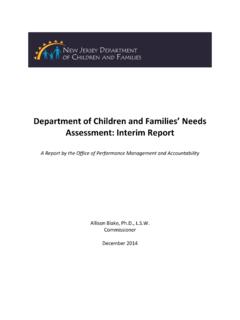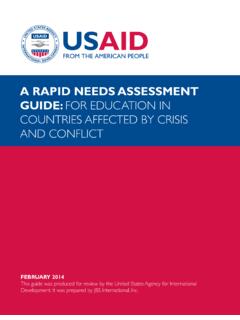Transcription of NEEDS ANALYSIS What Is Needs Analysis/Assessment? …
1 NEEDS ANALYSIS 1 NEEDS ANALYSIS What Is NEEDS ANALYSIS / assessment ? According to McKillip (1987), " NEEDS are value judgments: that a target group has problems that can be solved" (p. 7). NEEDS ANALYSIS , involving the identification and evaluation of NEEDS , is a tool for decision making in the human services and education. Decisions can be varied, including such as resource allocation, grant funding, and planning. In other words, NEEDS assessment is a process of evaluating the problems and solutions identified for a target population. In this process, it emphasizes the importance and relevance of the problems and solutions.
2 Models of Need assessment : * McKillip (1987) provides three models of NEEDS assessment : Discrepancy Model This model is the most straightforward and widely used, especially in education. This model emphasizes normative expectations and involves the three phases: Goal setting, identifying what ought to be Performance measurement, determining what is Discrepancy identification, ordering differences between what ought to be and what is Marketing Model This model defines NEEDS assessment as a feedback process used by organizations to learn about and to adapt to the NEEDS of their client populations.
3 A marketing strategy of NEEDS ANALYSIS has three components: Selection of the target population, those actually or potentially eligible for the service and able to make the necessary exchanges Choice of competitive position, distinguishing the agency's services from those offered by other agencies and providers Development of an effective marketing mix, selecting a range and quality of services that will maximize utilization by the target population Decision-Making Model This model is an adaptation of multiattribute utility ANALYSIS (MAUA) to problems of modeling and synthesis in applied research.
4 The decision-making model has three stages: Problem modeling: In this stage, need identification takes place. The decision problem is conceptualized by options and decision attributes. Quantification: In this stage, measurements contained in the need identification are transformed to reflect the decision makers values and interests. Synthesis: In this stage, an index that orders options on need will be provided. This index also gives information on the relative standing of these NEEDS . NEEDS ANALYSIS 2 Steps in NEEDS ANALYSIS : McKillip (1987) identified five steps in NEEDS ANALYSIS : Step 1: Identify users and uses of the need ANALYSIS .
5 The users of the ANALYSIS are those who will act on the basis of the report. Knowing the uses of the need ANALYSIS can help focus on the problems and solutions that can be entertained. Step 2: Describe the target population and the service environment. For example, geographic dispersion may include transportation, demographic characteristics of the target population, eligibility restrictions, and service capacity. Client ANALYSIS refers to the comparison of those who use services with those who are eligible to use services. Resource inventories detail services available. Step 3: Identify NEEDS .
6 Describe problems According to McKillip (1987), three types of problems are identified by need ANALYSIS : Discrepancies: Problems are revealed by comparison of expectations with outcomes. Discrepancies are problems (p. 11). Poor outcome: Problems involve those at-risk of developing poor outcomes Maintenance need: A group with maintenance NEEDS can develop poor outcomes if services presently offered are withdrawn or altered (p. 11). Bradshaw identified four types of outcome expectations that support judgments of NEEDS (McKillip, 1987): Normative need: Expectations based on expert identification of adequate levels of performance or service.
7 (This type of expectations may miss real NEEDS of target population.) Felt need: Expectations that members of a group have for their own outcomes ( , parents expectations about the appropriate amount of elementary level mathematics instruction). Expressed need: Expectations based on behavior of a target population. Expectations are indicated by use of services ( , waiting lists, enrollment pressure, or high bed occupancy rates). Comparative need: Expectations based on the performance of a group other than the target population. (Comparative expectations mainly depend on the similarity of the comparison group and the target population.)
8 In addition, such expectations can neglect unique characteristics that invalidate generalizations.) Describe solutions According to McKillip (1987), there are three criteria (dimensions) for evaluating solutions: Cost ANALYSIS Impact Feasibility NEEDS ANALYSIS 3 Step 4: Assess the importance of the NEEDS . Once problems and their solutions have been identified, NEEDS are evaluated. Step 5: Communicate results. Finally, the results of the need identification must be communicated to decisions makers, users, and other relevant audiences. Techniques for Need ANALYSIS Resource Inventory Information is gathered from service providers, either by survey or interview Provides a systematic mapping of services available, points to gaps and to widely available services.
9 And may identify services that planners were not aware of Secondary Data ANALYSIS Target population description Synthetic estimation Client ANALYSIS Direct and at-risk indicators Surveys Key informants Client satisfaction Training surveys Group Procedures Focus groups Nominal groups Public hearing and community forums Miscellaneous Points In practice, NEEDS ANALYSIS is an iterative and satisfying activity, which includes "the cycle of decision, data gathering, and data ANALYSIS repeats until further cycles are judged unnecessary" (McKillip, 1987, pp. 9-10). Because different stakeholders have different perspectives on NEEDS and solutions, NEEDS ANALYSIS usually involves the gathering of information from more than one referent group ( , clients, families, service providers).
10 Further, in planning NEEDS ANALYSIS / assessment (or any other research), it is important to consider multiple measures ( , different types of measures for the same construct) and different methods of assessment ( , client surveys questionnaires, key informant interviews; McKillip, 1987). NEEDS ANALYSIS 4 Based on the characteristics of NEEDS ANALYSIS , the major concepts of participatory action research (PAR) that involve consumers in the planning and conduct of research can be considered in NEEDS ANALYSIS . Activity Develop a program, including the mission, goals, and major activities. Now, discuss how you would conduct a need ANALYSIS , including identifying activities in the 5 steps outlined above and possible techniques that can be used for data collection.










